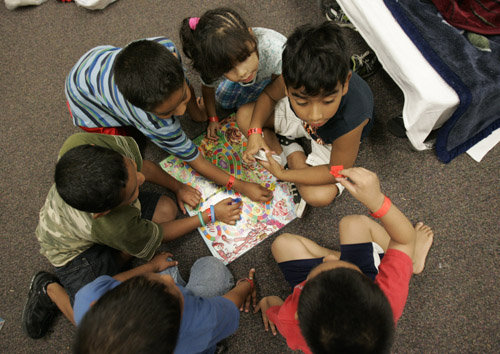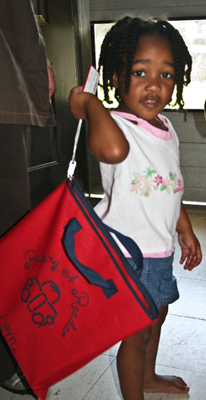Washington Nationals catcher Wilson Ramos, left, shakes hands with Venezuela's Justice Minister Tareck El Aissami at the end of a news conference at Judicial Police headquarters in Valencia, Venezuela, Saturday Nov. 12, 2011. Ramos' kidnapping ordeal ended after two days when police commandos rescued him in a flurry of gunfire. El Aissami said Saturday that authorities had arrested four of the captors, all of them Venezuelan men in their 20s. A 60-year-old woman and 74-year-old man were also arrested for supplying the kidnappers with food from their home in the area, he said. (AP Photo/Ariana Cubillos)
Washington Nationals catcher Wilson Ramos, left, shakes hands with Venezuela's Justice Minister Tareck El Aissami at the end of a news conference at Judicial Police headquarters in Valencia, Venezuela, Saturday Nov. 12, 2011. Ramos' kidnapping ordeal ended after two days when police commandos rescued him in a flurry of gunfire. El Aissami said Saturday that authorities had arrested four of the captors, all of them Venezuelan men in their 20s. A 60-year-old woman and 74-year-old man were also arrested for supplying the kidnappers with food from their home in the area, he said. (AP Photo/Ariana Cubillos)
Washington Nationals catcher Wilson Ramos attends a news conference at Judicial Police headquarters in Valencia, Venezuela, Saturday Nov. 12, 2011. Ramos' kidnapping ordeal ended after two days when police commandos rescued him in a flurry of gunfire Friday night. Authorities said they had arrested four of the captors, all of them Venezuelan men in their 20s. A 60-year-old woman and 74-year-old man were also arrested for supplying the kidnappers with food from their home in the area, he said. (AP Photo/Ariana Cubillos)
Venezuela's Justice Minister Tareck El Aissami, left, shows a picture of the SUV that Washington Nationals catcher Wilson Ramos was forced into at gunpoint, right, during a news conference at Judicial Police headquarters in Valencia, Venezuela, Saturday Nov. 12, 2011. Ramos' kidnapping ordeal ended after two days when police commandos rescued him in a flurry of gunfire Friday night. El Aissami said they had arrested four of the captors, all of them Venezuelan men in their 20s. A 60-year-old woman and 74-year-old man were also arrested for supplying the kidnappers with food from their home in the area, he said. (AP Photo/Ariana Cubillos)
Washington Nationals catcher Wilson Ramos attends a news conference at Judicial Police headquarters in Valencia, Venezuela, Saturday Nov. 12, 2011. Ramos' kidnapping ordeal ended after two days when police commandos rescued him in a flurry of gunfire Friday night. Authorities said they had arrested four of the captors, all of them Venezuelan men in their 20s. A 60-year-old woman and 74-year-old man were also arrested for supplying the kidnappers with food from their home in the area, he said. (AP Photo/Ariana Cubillos)
The alleged kidnappers of Washington Nationals catcher Wilson Ramos are presented to the media in the parking lot of the Venezuela's Judicial Police headquarters in Valencia, Venezuela, Saturday Nov. 12, 2011. Ramos' kidnapping ordeal ended after two days when police commandos rescued him in a flurry of gunfire Friday night. Authorities said they had arrested four of the captors, all of them Venezuelan men in their 20s. A 60-year-old woman and 74-year-old man were also arrested for supplying the kidnappers with food from their home in the area, he said. (AP Photo/Ariana Cubillos)
VALENCIA, Venezuela (AP) ? His eyes tearing up with emotion, Washington Nationals catcher Wilson Ramos embraced his rescuers Saturday and said he had wondered whether he would survive a two-day kidnapping ordeal that ended when commandos swept into his captors' mountain hideout.
Ramos said that he was happy and thankful to be alive a day after his rescue, saying that his final moments as a prisoner were hair-raising as police and the kidnappers exchanged heavy gunfire in the remote area where he was being held. He said his kidnappers had carefully planned the abduction and told him they were going to demand a large ransom.
"I didn't know if I was going to get out of it alive," Ramos told reporters at a police station in his hometown of Valencia, flanked by police investigators, National Guard commanders and Justice Minister Tareck El Aissami. "It was very hard for me. It was very hard for my family."
El Aissami said authorities arrested four of the captors, all of them Venezuelan men in their 20s. A 60-year-old woman and a 74-year-old man were also arrested as accomplices for supplying the kidnappers with food from their home in the area, he said. The six suspects were led past journalists at the police station with black hoods over their heads.
Authorities were still searching for four Colombian men who escaped during the rescue, El Aissami said. He didn't say whether anyone was wounded in the gunbattle.
Ramos, 24, was seized at gunpoint outside his family's home Wednesday night and whisked away in an SUV. It was the first known kidnapping of a Major League Baseball player in Venezuela, and the abduction set off an outpouring of candlelight vigils and public prayers at stadiums as well as outside Ramos' house.
El Aissami said investigators' first break in the case came when they found the kidnappers' stolen SUV, a bronze-colored Chevrolet, abandoned in the town of Bejuma alongside the mountains of central Carabobo state. With that location pinpointed, he said, they studied past crimes in the area and ended up checking on a rural house that authorities believed had been used in a previous kidnapping.
An SUV parked outside had mud on it even though there was no mud in the area, El Aissami said. Investigators suspected that SUV was being used to shuttle food to another spot nearby, and eventually determined the house was probably being used by the kidnappers as a support base while holding Ramos elsewhere, he said.
El Aissami said authorities took over the house and detained the couple who had been cooking for the abductors.
Once investigators thought they had found the general area where Ramos might be, President Hugo Chavez personally authorized an aerial search mission and teams also set out on foot in the mountainous area, El Aissami said. He said the teams searched most of the day on Friday and finally came upon the remote house where Ramos was being held.
Chavez followed the operation "minute by minute," the justice minister said.
Ramos had recently returned to his homeland after his rookie year with the Nationals to play during the offseason in the Venezuelan league.
When he was abducted, he was standing with his father and two brothers just outside the front door of his family home in a working-class neighborhood of Valencia, about 90 miles (150 kilometers) west of Caracas.
Ramos said his captors drove him for five or six hours, and once changed from one SUV to another. He said they bound his hands at first, but later allowed him not to be tied up. The kidnappers didn't cover their faces and they spoke little to him, he said.
"They demanded only money," he said.
Ramos said some of his abductors spoke with Colombian accents and revealed they had studied his movements before carrying out the abduction.
"They told me many things they knew of my private life," he said. "They knew a lot about me. They had very good information, an informant who told them all that."
Asked more about that informant, Ramos said he didn't have further details but that "they themselves told me."
El Aissami said one of the Colombians wanted by authorities lives in the area, and investigators believed he planned the kidnapping and studied Ramos' daily routine.
"This person is the one who gives the information to a criminal group," which in turn carried out the kidnapping, El Aissami said.
He said the investigation also pointed in part to "Colombian paramilitary groups that could be involved in the kidnapping."
Ramos said he was kept in a room and passed the time lying on a bed. When the gunfire erupted Friday as his rescuers arrived, "I was on the bed and I threw myself directly to the floor."
"It was like 15 minutes of shots until the officials arrived and saw me in the room," said Ramos, who hugged the justice minister as well as police and National Guard officers at the news conference.
Ramos said he was enjoying being back with his family, and planned to start training Monday to play with his Venezuelan team, the Aragua Tigres, on Wednesday.
He said he didn't plan to travel to Washington for now. "I want to stay here to give them that, to the Venezuelan people ... so that they can see me play here."
After his rescue was announced Friday night, Ramos' mother, Maria Campos de Ramos, celebrated, exclaiming on television: "Thanks to God!"
Nationals general manager Mike Rizzo also celebrated the news.
"He asked me to thank all who played a role in his rescue, and all those who kept him and his family in their thoughts and prayers," Rizzo said in a statement. "I join Wilson in thanking the many law enforcement officials in Venezuela and investigators with Major League Baseball who worked tirelessly to ensure a positive ending to what has been a frightening ordeal."
A baseball official said Major League Baseball's local security agents worked with Venezuelan law enforcement on the case. The official spoke on condition of anonymity due to the sensitivity of the situation.
Security has increasingly become a concern for Venezuelan players and their families as a swelling wave of kidnappings has hit the country's wealthy and middle class in recent years. Venezuela has one of the highest murder rates in Latin America, and the vast majority of crimes go unsolved.
Major League Baseball officials said it was the first kidnapping of a major leaguer that they could recall. But relatives of several players in Venezuela have previously been kidnapped for ransom, and in two cases have been killed.
Bodyguards typically shadow major leaguers when they return to their homeland to play in Venezuela's baseball league.
"They didn't physically harm me, but psychologically I underwent very great harm," Ramos said. "I was always praying to God, and thanks to God he gave me the miracle of sending me these wonderful people."
He saluted his rescuers, saying: "I'm alive thanks to them."
___
Associated Press writer Jorge Rueda in Caracas and AP sports writers Howard Fendrich in Washington and Ron Blum in New York contributed to this report. Rueda reported from Caracas.
Associated PressSource: http://hosted2.ap.org/APDEFAULT/347875155d53465d95cec892aeb06419/Article_2011-11-12-BBN-Venezuela-Ramos-Abducted/id-be7faa370bf446c796c4ddb00d35b091
sharjah sharjah observe and report observe and report auburn football auburn football vanderbilt



 Lightbank-backed
Lightbank-backed 

